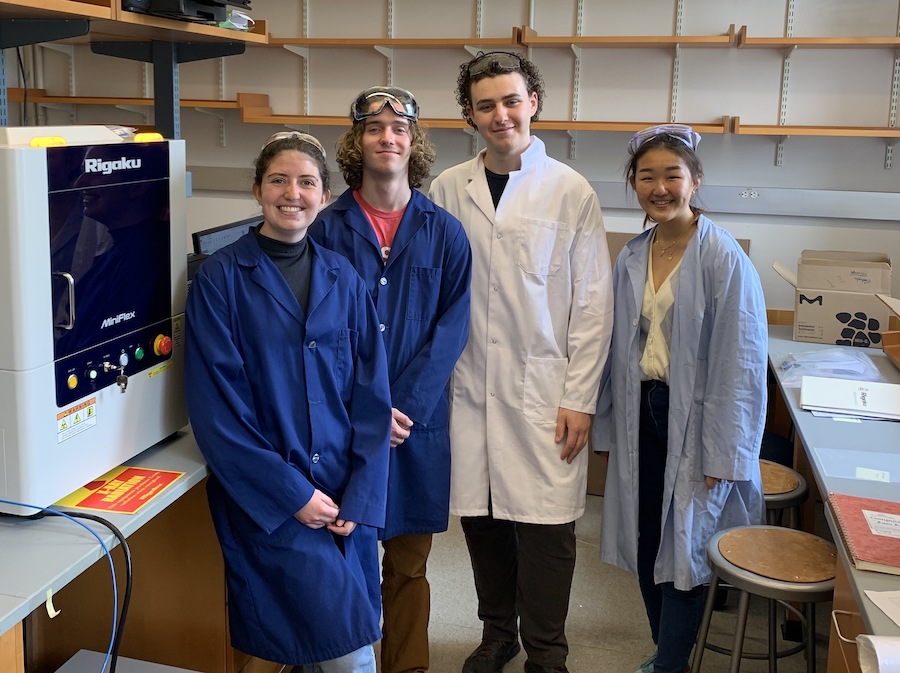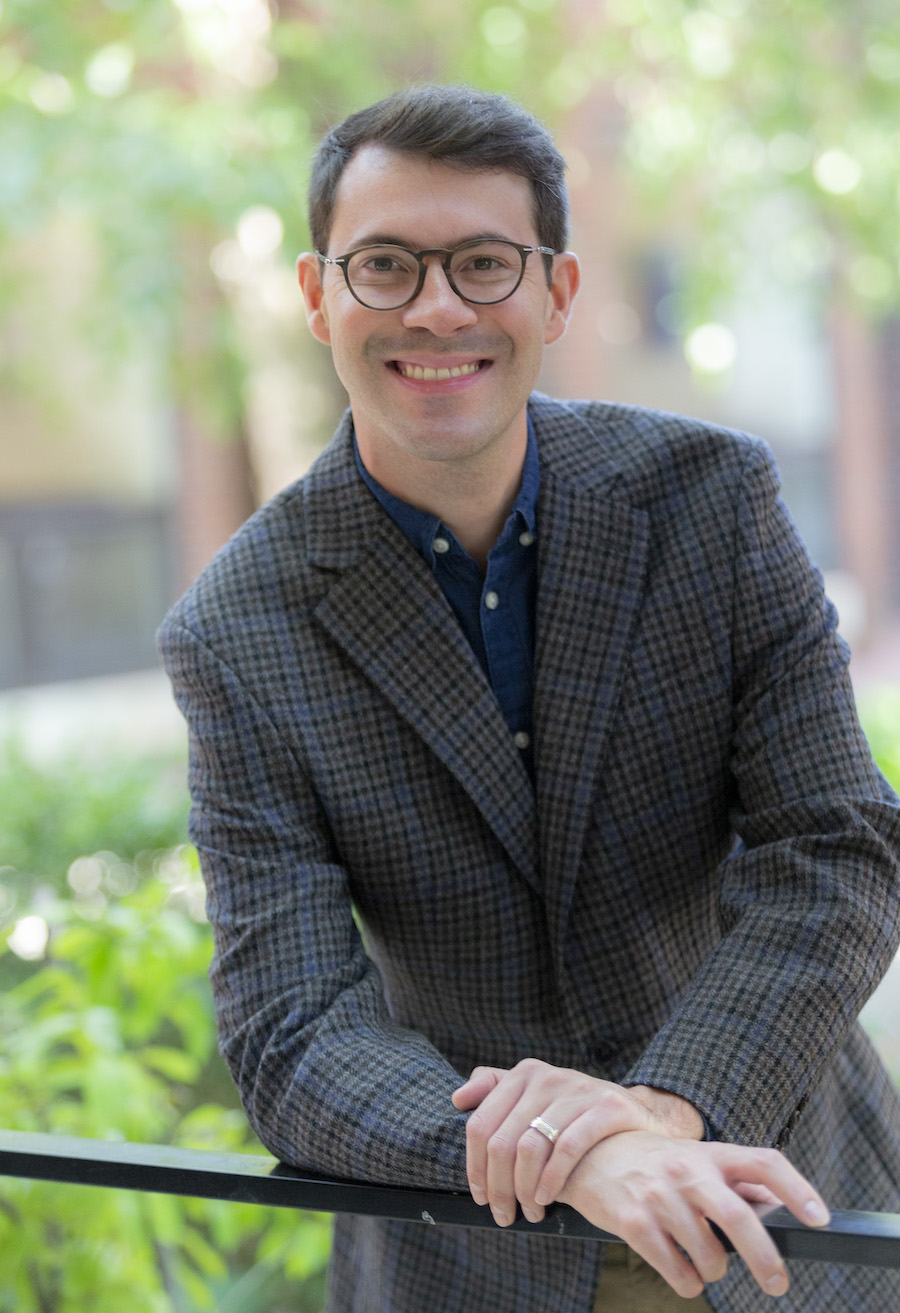Harnessing the Power of Crystals for Medicine, Energy, and the Environment
By Rebecca Goldfine
For the student chemists in Amnon Ortoll-Bloch's lab, crystals have the potential to clean up environmental pollutants, boost our energy transition to renewables, and improve the potency of medicines.
But to apply those assets to these modern-day problems, scientists need to first understand the intricacies of how the crystals form and develop, and how their internal structure and external shape and size are altered during chemical processes. In this precise work, small changes can have big impacts, and the end products can do very different things.
"The overall mission for my lab is to find correlations between how the crystals grow, the conditions in which they grow, and their properties and performance," Ortoll-Bloch said. "We're really interested in understanding the fundamentals of crystallization pathways because crystals are super useful. A lot of crystalline materials have very important applications, ranging from energy and environmental all the way to health, like pharmaceuticals."
This summer Ortoll-Bloch hired four students—Morgan Adams ’24, Gabriel Bloom-O'Sullivan ’25, Brendan Hill ’25, and Isabelle Lee ’25—as lab assistants. Besides conducting experiments, they're setting up equipment and protocols for Ortoll-Bloch's first summer of research as assistant professor of chemistry at Bowdoin.

Each student received a grant from the College to join the team. "They're getting a behind-the-scenes look at how you start a research lab by setting up equipment and protocols for everything we want to do," Ortoll-Bloch said.
The students say they've enjoyed this start-up process because it has allowed them to contribute to the lab's direction. "With other labs that are super well-established, it seems as though students aren’t given that much choice of what to study," Hill said. "Here we get a lot more say."
The student team is also excited to learn about a field of chemistry new to them—one that is a fast-moving, exciting area of discovery. "In the last few decades, a lot of new research has shown a myriad of possible pathways by which crystals can grow that we didn't know existed, and new tools are being developed to look at crystals growing in real time," Ortoll-Bloch said.
In his lab, the four students have broken into pairs focusing on two areas: active pharmaceutical ingredients and materials for energy and environmental applications.
"Inorganic chemistry is an aesthetic and beautiful branch of chemistry. In the lab you see these brilliant colors you’ll never see in an organic lab, where everything is white. With inorganic chemistry, you see purple, you see blue, you see shimmery colors, the entire rainbow. So it hooked me right away," said Isabelle Lee, who is an English major and chemistry minor.
Team Cobalt Oxide
Bloom-O'Sullivan and Lee are investigating the most efficient, fastest, and least expensive crystallization processes for synthesizing cobalt hydroxide carbonate and transforming it into cobalt oxide, a valuable substance for many industries, Lee explained.
"Cobalt oxide is used for a variety of things," Bloom-O'Sullivan continued. "It's a catalyst for creating hydrogen fuel and a lot of electronics—like semiconductors, super conductors, batteries, solar panels, and sensors to detect carbon dioxide. It's a cheaper alternative to rarer earth metals."
They're starting with a number of cobalt hydroxide carbonate samples that a previous honors student, Zubin Kenkare ’23, had made for the lab. Each sample is slightly different, with different additives and different concentrations of ingredients used to make each sample.
Bloom-O'Sullivan and Lee are running the powdery samples through various processes to see how the crystals are altered. "Isabelle and I are figuring out which synthesis conditions can lead to which crystal shapes that can be tied to which properties," Bloom-O'Sullivan said. "So if we're looking for a crystal that is good for a semiconductor or a battery, we know which crystal shape works that can be created with this specific synthesis process."
Team Aspirin and Flufenamic acid
Adams and Hill are experimenting with the active ingredients in two pharmaceutical products, aspirin and flufenamic acid. Flufenamic acid, like aspirin, is as an anti-inflammatory drug. Understanding drugs' crystalline structures is critical because the crystals influence how well the medicine performs in the body, such as determining how much of it dissolves in the bloodstream or how easily it is compressed into a tablet.
If they develop a means of controlling the crystallization of their model drugs and end up with a desirable form, they can apply that knowledge to other drugs, Hill explained.
"Brendan and I are figuring out how to make one form of aspirin over another and what specific conditions lead to specific forms," Adams said. "That means changing concentrations, adding things to the growth mixture, growing the crystals on different surfaces—all these factors contribute."
She added, "It is trial and error, and small things like that can have a big impact."
The Appeal of Inorganic Chemistry and Materials Science
Adams was drawn to Ortoll-Bloch's lab after doing an internship for a pharmaceutical company that was trying to make drugs to treat Parkinson’s disease. Though the lab had two promising front-runners, one was extremely soluble—meaning it could dissolve easily in the bloodstream and reach the target area—but it had poor bioavailability, which is how much of the drug is available in the body to bind with the desired target. Whereas the other had poor solubility but excellent bioavailability.
When she learned about Ortoll-Bloch's area of research, her interest was piqued. "I was like, 'Huh, that could be interesting if you could take this pharmaceutical and alter its crystal structure to make it more soluble, that could that help solve some of these issues.'"
Lee is a chemistry minor and English major but wanted the experience of working in a chemistry lab. "Chemistry is all about relationships, cause and effect, and time, which feels very narrative to me," she said, explaining the overlap of her two areas of study. She is considering pursuing a career in health care after she graduates.
Bloom-O'Sullivan was drawn to the opportunity after working in Ben Gorske's organic chemistry lab. Ortoll-Bloch's inorganic chemistry lab, he decided, would be "an interesting counterpoint." He added, "Digging further into the kinetics of crystallization is hugely interesting to me because ultimately I will end up in a PhD program doing biomedical research."
Morgan, too, plans to apply to PhD programs in chemistry after graduating from Bowdoin. "These techniques are so much fun to use," she said about her time working with Ortoll-Bloch. "For me it is quite valuable, because when I apply to grad school, I can do organic, inorganic, or something that combines both of them, or try something completely different! And I can apply different perspectives and approaches to solve problems."
Hill said he, too, hopes to pursue a PhD in chemistry after graduating from Bowdoin. Though he is not yet sure which area he wants to specialize in, he said, "I am interested in any chemistry that has an application, and two of those applications that I wanted to explore are pharmaceuticals, because they help people, and environmental, to save the environment. Both of those are addressed in this lab."